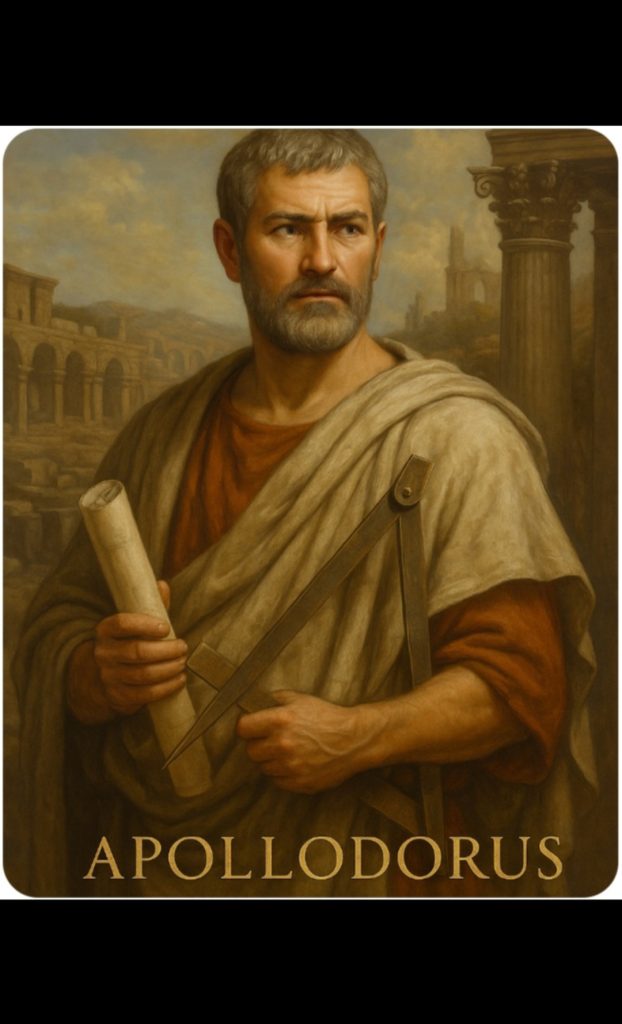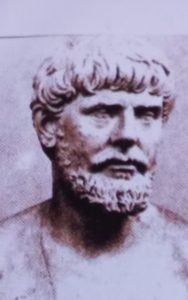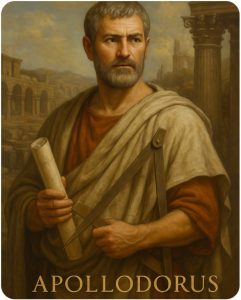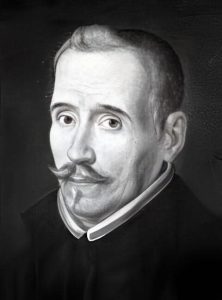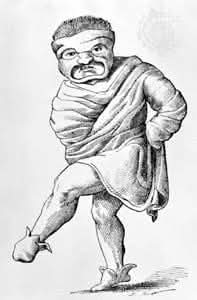المعماري الدمشقي أبولودور.عبقري سوري أدهش العالم – إعداد: فريد ظفور
المعماري الدمشقي أبولودور.
من هو أبولودور
عبقري سوري أدهش العالم
أبولودور الدمشقي معماري و مخطط مدن و نحات
*تمثال نصفي الأبولودور موجود في متحف الحجريات بمدينة ميونيخ الألمانية.
ولد أبولودور في دمشق حوالي ٦٠م و توفي منفيا عام ١٢٥م، عاش تحت سمائها، و غب من مائها، وتغذى بخيراتها،
عمل في روما في النصف الأول من القرن الثاني الميلادي و هو الشخصية الفنية الكبرى التي يمكن تميزها في خضم جهلنا لأسماء مبدعي الفن في العصر الروماني.
صفاته:
أبولودور جميل الرجولة متين البنية متوازن الشخصية، ذو سمات شرقية واضحة يتصدى لأصعب المعضلات التقنية والفنية.
و عظمة أبولودور برزت في قدرته على تصميم و تنفيذ المشاريع الكبيرة، مما أدى إلى نتاج غاية في الجرأة والتجديد من حيث تشكيل الفراغات الخارجية والداخلية و التكوينات الزخرفية المتحررة من شرائع العمارة الكلاسيكية، حيث ظهرت أبعاد جديدة في مجال التخطيط العمراني و مظاهر إثراء في التشكيل المعماري.
إن الأسلوب المعماري و التخطيطي الذي انتهجه أبولودور في عمارة و عمران روما القديمة، يتشابه إلى حد كبير مع العمارة و العمران المشرقي الذي كان منتشرا آنذاك جنوب بلاد الشام في دمشق و البتراء و مدائن صالح، يؤكد على الهوية و الجذور المشرقية لهذا المعمار و ليس لمجرد لقب -أبولودور الدمشقي.
لقاء رجلين و حضارتين
عاش أبولودور في زمن الإمبراطور الروماني تراجان ما بين ۹۸-۱۱۷م، بعد أن جمعتهما صداقة حميمة منذ كان الأخير يخدم كمحام عسكري في سورية و كان أبوه واليا عليها. وقد اختاره تراجان مهندسا للإمبراطورية لإعجابه بقدراته و مميزاته الهندسية ذاع على أثرها صيت أبولودور و عظمت شهرته.
أهم منجزات أبولودور
١ – الجسر العملاق على نهر الدانوب
۲- عمود ترجان
٣- السوق على سفح رابية الكوربريناليس.
٤- الميدان الفوروكوم الترجاني
ه – دار العدل الأولمبية.
٦ – المكتبات.
٧- قوس النصر في مدينة أنكونا .
٨- إصلاح قناة من النيل إلى البحر.
٩- كتاب مؤلف في آلات الحصار أهداه لهدريانوس.
١٠- تجفيف المستنقعات البونتية.
* مقتطفات من كتاب أبولودور الدمشقي أعظم معماري في التاريخ القديم للدكتور عدنان البني يرى ليوني هومو : أن التأثيرات الشرقية في سورية ضعفت بسبب السلوقيين،
وسعيهم في تعميم الثقافة الهيلينية، ولكن عند سقوطهم عادت تلك التقاليد الشرقية، وحاولت روما بعد سيطرتها على البحر المتوسط استبعاد هذه التأثيرات، فلم تفلح إلا في التخفيف من أثرها ، لكن في القرن الثاني الميلادي ظهرت من جديد الموجة الشرقية في ميدان الفن.
و في رأي بيانكي باندينيللي: إن أكثر الدفعات حيوية كانت تأتي غالبا من مقاطعات الشرق سواء في الفكر أم في الفن و منها يأتي أنشط رجال السياسة و أكفأ الموظفين والقادة العسكريين و هذا التداخل بين روما و الدويلات الشرقية برز بشكل خاص في السلالة الأنطونية سلالة ثيرفا و ترجان و هيدرياتوس … الخ، لدرجة تحيل معها النظر للفن الروماني بعد ذلك العصر، من زاوية النظر لروما وحدها”.
و يذكر تاريخ “كامبردج أن بعض العلماء يعتقدون أن سورية تفوقت على روما في عبقريتها المبدعة و في معارفها التقنية و في مهارة عمالها، و يفترض أن “أبولودور الدمشقي قد اقتبس تصميمات المباني في سفح الكورينالس عن موطنه الأصلي).
يقول الشاعر اللاتيني “جوفينال”: أن العاصي السوري أخذ يصب مياهه منذ وقت طويل في نهر التيبر حاملا معه لغته و عاداته.
********
Who is Apollodorus?
A Syrian genius who amazed the world.
Apollodorus of Damascus, architect, city planner, and sculptor.
A bust of Apollodorus is located in the Stone Museum in Munich, Germany.
Apollodorus was born in Damascus around 60 AD and died in exile in 125 AD. He lived under its sky, drank its water, and was nourished by its bounty. He worked in Rome during the first half of the second century AD and is a major artistic figure who can be distinguished amid our ignorance of the names of the creators of art in the Roman era.
His Characteristics
Apollodorus was handsome, muscular, and balanced in his personality. He possessed clear Eastern traits and was able to tackle the most difficult technical and artistic challenges.
Apollodorus’s greatness was evident in his ability to design and implement large-scale projects, resulting in a product of extreme boldness and innovation in terms of shaping external and internal spaces and decorative compositions free from the canons of classical architecture. This resulted in new dimensions in urban planning and enriching architectural design.
The architectural and planning style adopted by Apollodorus in the architecture and construction of ancient Rome closely resembles the Eastern architecture and construction that was prevalent at that time in the southern Levant, in Damascus, Petra, and Mada’in Saleh. This emphasizes the Eastern identity and roots of this architecture, and not simply the title of Apollodorus of Damascus.
A Meeting of Two Men and Two Civilizations
Apollodorus lived during the reign of the Roman Emperor Trajan, between 98 and 117 AD. They had developed a close friendship since Trajan served as a military lawyer in Syria, where his father was governor. Trajan chose him as an engineer for the empire, impressed by his abilities and engineering qualities. Apollodorus’s fame and reputation spread.
Apollodorus’s Most Important Accomplishments
1. The Great Bridge over the Danube
2. Trajan’s Column
The Market Place on the Slope of the Corbrinali The Forum of Trajan
5. The Olympic Courthouse
6. Libraries
7.The Arch of Triumph in Ancona
8. Repair of a canal from the Nile to the sea
9. A book on siege engines dedicated to Hadrian
10. Draining the Pontic Marshes
Excerpts from the book Apollodorus of Damascus, the Greatest Architect in Ancient History, by Dr. Adnan Al-Bunni. Leoni Homo believes that Eastern influences in Syria weakened because of…
The Seleucids and their efforts to spread Hellenic culture. However, upon their fall, these Eastern traditions returned. After Rome’s control of the Mediterranean, it attempted to eliminate these influences, but only succeeded in mitigating their impact. However, in the second century AD, the Eastern wave reappeared in the field of art. In Bianchi Bandinelli’s opinion, “The most vital impulses often came from the eastern provinces, both in thought and art, and from them came the most active politicians, the most capable officials, and the most capable military leaders. This intermingling between Rome and the eastern states was particularly evident in the Antonine dynasty, the dynasty of Theravada, Trajan, and Hydratus, etc., to the point that Roman art after that era is viewed solely from the perspective of Rome.”
The Cambridge History notes that some scholars believe that Syria surpassed Rome in its creative genius, technical knowledge, and the skill of its workers. It is postulated that “Apollodorus of Damascus borrowed the building designs of the Corinthians from his original homeland.”
The Latin poet Juvenal says that the Syrian Orontes had long since begun to flow into the Tiber, carrying with it its language and customs.
***********************
المراجع والمصادر:
مواقع إجتماعية- فيس بوك
